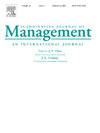The theory of temporary organization three decades later: Re-visiting the 4 T framework, focusing tensions, adding project plasticity
IF 2.5
4区 管理学
Q3 MANAGEMENT
引用次数: 0
Abstract
For more than three decades, the notion of temporary organization in general, and the 4 T framework in particular, has informed research on managing projects. In a similarly important way, it has helped to connect this field of scholarly inquiry more closely with management and organization studies. While the 4 T framework with its four dimensions (time, task, team, and transition) has often been referred to, few have criticized or developed it further. In this paper we review the respective literature and propose to focus more on practices and tensions and, in particular, add the tension-ridden concept of project plasticity, which captures the ability of projects to change substantially and yet stay the same in the eyes of those involved. But instead of adding a fifth T, we highlight with this addition the fundamental tension between stability and change. Like the classic and already well-researched tension between organizational autonomy and contextual embeddedness this particular tension is not only extremely relevant for managing temporary organizations, but also cuts across the four classic dimensions and refines our understanding of the dynamic nature inherent to temporary organizations. We illustrate our argument with the example of an interorganizational project from the construction industry.
三十年后的临时组织理论:重新访问4 T框架,聚焦张力,增加项目可塑性
三十多年来,临时组织的概念,特别是4 T框架,已经为管理项目的研究提供了信息。以同样重要的方式,它有助于将这一学术研究领域与管理和组织研究更紧密地联系起来。虽然经常提到具有四个维度(时间、任务、团队和转换)的4 T框架,但很少有人批评或进一步发展它。在本文中,我们回顾了各自的文献,并建议更多地关注实践和紧张关系,特别是增加项目可塑性的紧张感概念,它捕获了项目发生实质性变化的能力,但在参与者眼中保持不变。但是,我们没有增加第五个T,而是强调了稳定与变化之间的基本张力。就像组织自主性和上下文嵌入性之间的经典和已经得到充分研究的紧张关系一样,这种特殊的紧张关系不仅与管理临时组织极其相关,而且跨越了四个经典维度,并改进了我们对临时组织固有的动态性质的理解。我们以建筑业的一个跨组织项目为例来说明我们的论点。
本文章由计算机程序翻译,如有差异,请以英文原文为准。
求助全文
约1分钟内获得全文
求助全文
来源期刊

Scandinavian Journal of Management
MANAGEMENT-
CiteScore
4.00
自引率
10.00%
发文量
36
审稿时长
71 days
期刊介绍:
The Scandinavian Journal of Management (SJM) provides an international forum for innovative and carefully crafted research on different aspects of management. We promote dialogue and new thinking around theory and practice, based on conceptual creativity, reasoned reflexivity and contextual awareness. We have a passion for empirical inquiry. We promote constructive dialogue among researchers as well as between researchers and practitioners. We encourage new approaches to the study of management and we aim to foster new thinking around management theory and practice. We publish original empirical and theoretical material, which contributes to understanding management in private and public organizations. Full-length articles and book reviews form the core of the journal, but focused discussion-type texts (around 3.000-5.000 words), empirically or theoretically oriented, can also be considered for publication. The Scandinavian Journal of Management is open to different research approaches in terms of methodology and epistemology. We are open to different fields of management application, but narrow technical discussions relevant only to specific sub-fields will not be given priority.
 求助内容:
求助内容: 应助结果提醒方式:
应助结果提醒方式:


